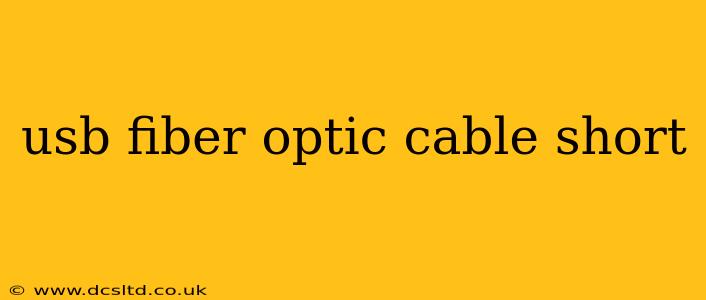Short USB Fiber Optic Cables: A Deep Dive into High-Speed, Short-Distance Connectivity
The demand for high-speed data transfer is ever-increasing, and short USB fiber optic cables are emerging as a crucial solution for applications requiring both speed and compact design. While traditional copper USB cables suffice for many needs, fiber optic cables offer significant advantages, particularly in scenarios where minimizing signal degradation and maximizing bandwidth are paramount. This detailed exploration delves into the nuances of short USB fiber optic cables, addressing key aspects and frequently asked questions.
What are the benefits of using a short USB fiber optic cable?
Short USB fiber optic cables offer several key advantages over their copper counterparts, especially in demanding applications:
-
Superior Bandwidth: Fiber optic cables boast significantly higher bandwidth capabilities than copper cables. This translates to faster data transfer speeds, crucial for applications like high-resolution video streaming, data backups, and transferring large files. The difference becomes especially pronounced with shorter cables as signal degradation in copper cables is less of a factor over short distances.
-
Immunity to Electromagnetic Interference (EMI): Unlike copper cables, fiber optic cables are immune to electromagnetic interference. This makes them ideal for environments with high levels of electrical noise, ensuring reliable data transmission without signal corruption.
-
Enhanced Security: Fiber optic cables offer superior security against eavesdropping. The light signals traveling within the fiber are virtually impossible to tap into without detection.
-
Longer Lifespan: Fiber optic cables generally have a longer lifespan than copper cables, owing to their robustness and resistance to signal degradation.
What are the applications for short USB fiber optic cables?
Short USB fiber optic cables find applications in a variety of settings where speed and reliability are critical:
-
Industrial Automation: In industrial control systems and robotics, data needs to be transmitted quickly and reliably. Short fiber optic cables provide a robust solution to this challenge.
-
Medical Imaging: High-resolution medical imaging systems require incredibly fast data transfer rates. Short fiber optic cables are ideal for this.
-
Data Centers: Short-distance interconnects within data centers benefit from the speed and reliability of fiber optic cables.
-
High-Speed Data Acquisition: Scientific research and engineering often require the rapid acquisition of large amounts of data. Short fiber optic cables help achieve this.
-
Broadcast Studios: For high-quality video streaming, the bandwidth of fiber optics surpasses copper.
What is the difference between a USB fiber optic cable and a standard USB cable?
The primary difference lies in the transmission medium. Standard USB cables use copper conductors to transmit data as electrical signals, while USB fiber optic cables use glass or plastic fibers to transmit data as light signals. This fundamental difference results in the superior bandwidth, EMI immunity, and security of fiber optic cables. The USB connection on both types is the same, allowing for seamless connectivity with standard USB devices.
Are short USB fiber optic cables expensive?
Compared to standard copper USB cables, fiber optic cables generally command a higher price. However, the cost difference is often justified by the superior performance and long-term benefits, particularly in demanding applications where reliability and speed are paramount. The cost also varies depending on cable length, connector type, and quality. Shorter cables are generally less expensive than longer ones.
How long is a short USB fiber optic cable?
The definition of "short" is somewhat subjective and depends on the application. However, short USB fiber optic cables typically range from a few centimeters to a few meters in length. The ideal length depends on the specific requirements of the application.
How do I choose the right short USB fiber optic cable for my needs?
Selecting the correct cable necessitates considering several factors:
- Cable Length: Determine the exact distance needed for your application.
- Connector Type: Ensure the cable connectors are compatible with your devices (e.g., USB-A to USB-C).
- Bandwidth Requirements: Select a cable with a bandwidth sufficient to handle your data transfer needs.
- Fiber Type: Different fiber types offer different characteristics; consult the specifications to match your application.
Choosing the right short USB fiber optic cable can significantly enhance the performance and reliability of your systems. Understanding the benefits and key considerations outlined above will empower you to make an informed decision. Remember to consult with a specialist if you need assistance determining the appropriate cable for your specific application.
